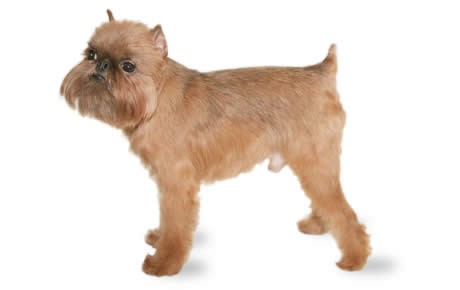Brussels Griffon Breed Guide

Breed Group:
Companion Dogs
Get 30% off
Join our Newsletter
Sign Up Today
Brussels Griffon Dog Breed Info & History
As the name suggests, Brussels Griffons originated in Belgium. Researchers believe that Pugs, Toy English Spaniels, and Affenpinschers were bred together to form the Brussels Griffon we know today. During the 1800s, this breed was used for their impeccable hunting skills. Their short and sturdy bodies allowed them to easily catch small animals like rats and other rodents that were lurking in stables and farmland. Finally, by the late 1800’s, Europeans developed a written standard for this breed which outlined their signature appearance and personality. Queen Marie Henriette became quite fond of these
Queen Marie Henriette became quite fond of these dogs and began breeding and promoting them herself. This increased the Brussels Griffon popularity all throughout Europe and even in the United States. By 1900, this dog was recognized by the American Kennel Club as an official breed in America. Sadly this breed saw a major decline during both world wars.
Many people could not afford to keep a dog as a pet, let alone continue breeding them. If it wasn’t for committed English breeders, the Brussels Griffon would have become extinct in Belgium during these tough times. Today this breed is a favorite among many pet owners. Their human-like face and petite size give them an iconic look that is unlike any other breed. Once this dog is in a loving household, they will be extremely loyal and affectionate to their owner. Read on below for more Brussels Griffon info.
Read on below for more Brussels Griffon info.
Brussels Griffon Temperament & Personality
The Brussels Griffon personality is very unique. Depending on their training and genetics, some Brussel Griffon traits may be outgoing and hyper, while others are timid and shy. For the most part, they tend to have a mind of their own and will take advantage of their owners when given the chance. Once this dog is properly trained by their owners, they can be the most loving and dedicated pet of all time. The Brussels Griffon personality traits are not the best for a larger family. They constantly need attention from their owners and do not like to compete with other pets.
Empty nesters are great for this breed because they are able to provide the attention and care the Brussels Griffon needs. Make sure to socialize your pet with different people, places, and experiences as early as possible. This will help them to become a well-behaved pup later on in life. The younger you start this process, the more comfortable they will feel on a day to day basis. All in all, the Brussels Griffon can be a great companion. With proper training and socialization, this breed will be a man’s best friend in no time at all!
Brussels Griffon Trainability
When it comes to training your Brussels Griffon, make sure to be consistent and patient. They tend to be quite independent and will ignore any training efforts if it does not interest them. When experiencing stubborn Brussels Griffon behavior, try enrolling them in a puppy training course for extra support. You will want to begin the training process as young as possible. Familiarize your pet with new people so they become comfortable in a busy setting. The only way your dog is going to be trained is if they learn to respect you.
Establish yourself as their master with firm and consistent commands. However, be careful not to be too hard on them. They are a very sensitive breed and may begin to snap at their owners out of fear. Aggressive treatment can also take a toll on their mental state and cause them to develop anxiety or become depressed. Always use positive reinforcement and praise when your pet has done a good job. The Brussels Griffon performs best when they are treated in a nice and calm manner. Use treats and encouragement when crate training or command training.
Exercise Requirements for Brussels Griffons
Luckily for pet owners, the Brussels Griffon does not require a lot of exercise. While they do enjoy daily walks, many will get their daily exercise just by running around the house and playing with their family. This makes the Brussels Griffon a great breed for elderly people or individuals who live in an apartment.
Just like all short-nosed breeds, the Brussels Griffon can easily become overheated while exercising, which can lead to heat stroke. Make sure to be aware of this and only take them for walks in moderate temperature. On warm summer days, make sure your pet is able to stay nice and cool inside the house. They are also sensitive to extreme weather conditions, so don’t keep your pet in the backyard all throughout the day.
Brussels Griffon Lifespan
The life expectancy of a Brussels Griffon is around 12 to 15 years.
Popularity of the Brussels Griffon
Throughout history, Brussels Griffons have always fluctuated in their popularity. Once Queen Marie Henriette began promoting this breed back in the 1800’s, they finally saw their first rise in popularity throughout Europe. After they came to America, they continued to fluctuate in their popularity, dependent on the “trends” in dog breeds. Today the American Kennel Club ranks the Brussel Griffon as the 97th most popular breed in the U.S.
Feeding Recommendations for Brussels Griffons
Because of their petite size and low energy level, this breed does not require a large amount of food on a daily basis. Professionals recommend anywhere from ¼-½ cup of high-quality food a day, split into two separate meals. It’s important to note that this amount varies on several favors. Their size, age, metabolism, and activity level should all be considered when creating a proper feeding regimen for your pet.
If you are confused on how much you should be feeding your Brussel Griffon, contact your veterinarian for professional help. Most importantly, make sure you are feeding your pet all natural and healthy ingredients. What you feed your pet will be a direct reflection of their overall health and longevity. Try to avoid pet food companies that have preservatives, soy, and corn as their main ingredients. Make sure to carefully read the labels of your dog food before feeding it to your pet.
Grooming a Brussels Griffon
The Brussels Griffon can either have a smooth or rough coat. While the rough coat requires more maintenance, they both need frequent brushing to stay clean and healthy. Professionals recommend using a slicker brush to rid the coat of loose and dead hair. Many Brussels Griffon have an iconic beard that also needs to be brushed to prevent tangles or matting. Also be sure to brush a Brussels Griffon teeth a couple of times a week.
Dental disease often affects all breeds, which can easily be prevented through frequent brushing. This will help to reduce bacteria and tartar build-up. Along with your weekly brushing, make sure to check their ears for wax buildup or infection. You can use a veterinarian-approved solution and cotton ball to clean their ears. Lastly, in the grooming process, trim your dog’s nails a few times a month so they don’t become overgrown or infected.
Are Brussels Griffons Good With Kids?
Brussels Griffon are not suited for having children in the same household. They can get along with other dogs, however, younger children can be too much to handle for them. Brussels Griffon’s do not like annoying and hyper children roughhousing with them, and may begin to bite or nip if feeling anxious. This breed wants all the attention for themselves, and they won’t be happy having to share it with a loud and aggressive toddler. Older children who know how to properly interact with a dog would be a better fit for this breed.
Another reason a child should not be around a Brussel Griffon is because they are a very fragile breed. Owners have to be careful in general when dealing with a toy breed, and that’s especially the case when children are around. Children are clumsy and rough – the last thing you want is your child accidentally stepping, dropping, or sitting on your tiny pooch. In order to prevent any accidents and injuries, do not let a toddler and a Brussels Griffon live under the same roof.
Brussels Griffon Health Problems
For the most part, Brussels Griffons are a fairly healthy breed, however, they are still prone to several health conditions. Below is a list of the most common Brussels Griffon health issues.
Eye problems: This small breed is prone to several eye problems. Irritation and redness are very common for Brussels Griffons and should be closely monitored for scratches or other injuries.
Patella Luxation: This inherited defect occurs when the thigh bone, kneecap, and calf do not properly align. Commonly seen in toy breeds, the Brussels Griffon is more susceptible to Patella Luxation, which can lead to lameness, inflammation, or arthritis.
Hip Dysplasia: Hip dysplasia is a common complication where the thigh bone does not fit properly in the hip joint. This affects the rear legs and can lead to lameness or arthritis in severe cases. Most of the time hip dysplasia is hereditary but it can also be brought on by injury or environmental factors.
Progressive Retinal Atrophy: PRA is a common eye condition that affects a dog’s nighttime vision. Once this disease worsens, it can lead to complete blindness in severe cases.
Hypothyroidism: Hypothyroidism is a condition where the body does not produce enough thyroid hormones which can lead to fluctuation in weight as well as skin issues. Luckily for owners, hypothyroidism can easily be cured by taking a synthetic hormone pill.
More Resources
National Breed Website: American Brussels Griffon Association
Brussels Griffon Rescue: National Brussels Griffon Rescue, Inc.





